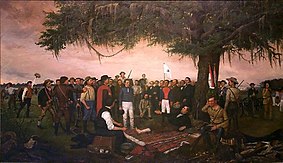Robert M. Coleman (Texan politician)
Template:New unreviewed article
This article may require cleanup to meet Wikipedia's quality standards. The specific problem is: new page created to correct wiki links that were going to the wrong person. (April 2016) |
Robert M. Coleman | |
|---|---|
| signer Texas Declaration of Independence | |
| signer Constitution of the Republic of Texas | |
| namesake Coleman County, Texas | |
| commanded a Texas Ranger division | |
| In office 1836–1837 | |
| namesake Coleman's Spring | |
| 1st Commanding Officer of Coleman's Fort | |
| In office namesake and constructor 1836 – 1836/37 | |
| Succeeded by | Maj. William H. Smith |
| Alcalde (Mayor) of Mina (now Bastrop,TX) | |
| In office elected 1834 – term tbd | |
| Personal details | |
| Born | said to be the same as Robert Morris Coleman b.1799 Kentucky, U.S. |
| Died | July 1, 1837 (aged 38) Brazos River at Velasco, Texas, U.S. |
| Resting place | missing from accidental drowning (contested) |
| Military service | |
| Allegiance | |
| Branch/service | United States Army Army of the Republic of Texas |
| Years of service | U.S. Army Texian Army: 1835–36 |
| Rank | U.S. Army: Corporal Texian Army: |
| Battles/wars | • Texas Revolutionary War • Battle of Concepción • Battle of San Jacinto |
Robert M. Coleman (1793 - July 1, 1837) was an American Texan politician and soldier, aide-de-camp to Sam Houston; said to be his sober antithesis and the true hero of the republic. Signer of the Texas Declaration, Colonel, and a transitional founder of the Republic of Texas into the United States as a constituent state. His said stance opposing the strategies of Sam Houston regarding defense of the Alamo, and troup placements on up through the Battle of San Jacinto caused a rift with Houston and a posturing treatise, lending suspicion to the untimely death of Coleman by drowning.
He was appointed one of the first Texas Rangers, whose outpost Coleman's Fort was later named Fort Colorado. The State Historic site marker now sits within Austin, Texas. [1] [2]
On February 1, 1858 he became the posthumous namesake of Coleman county, Texas and thus apparently also Coleman City, Coleman Lake, and eventually many other features, places, businesses, and identifiers in Coleman county, Texas. [3] [4]
Earlier writers include Noah Smithwick, a contemporary frontiersman, stationed at Coleman's Fort, having an awareness of Coleman in Smithwick's book 'Recollections of old Texas Days'. [5] [6]
The late Sherrianne Coleman Nicol, a possible relative or descendant, has written a detailed biography found in narrative-script form as of April 27, 2016 at Ancestry dot com [7] which suggests that Robert M. Coleman may have ancestral heritage from the often cited proposed Mobjack Coleman lineage of colonial Virginia. Her article includes a substantial bibliography.
It is implied that his family's association with Sam Houston may have began back in that Appalachian Virginia near Rockbridge Timber Plantation from where the Sam Houston family migrated, it being adjacent to a Coleman Mountain and Coleman Falls in southwest Amherst county and Nelson counties where some of the Mobjack Coleman lineage settled, both surnames typically attributed to Ireland.
Republic of Texas
Era
The Texas Revolution
Many events followed a similar timeline to that of Sam Houston
It has yet to be determined if any images exist with Sam Houston that might include the person of his aide-de-camp Robert M. Coleman.
Participant in the Republic of Texas
Coleman is not listed in the Old Three Hundred of the Stephen F. Austin contract with Spain, yet some of Robert's land references are noted within the Austin Colony. Coleman appears to have arrived in Texas as a part of the Robertson Empresario recruitment. [8]
Settlement of Mina (now Bastrop, Texas)
Elected Alcalde (Mayor) in 1834. He was resident of Mina at the time he signed the Texas Declaration of Independence
Author of war diary demeaning Sam Houston
Houston and his siding contingent denied the allegations of drunkenness and disregard for the safety of Texas troops. The distributed copies of Coleman's pamphlet are apparently rare to find in surviving form, and may have been burned or suppressed after his death.
Father and Husband
Protector and defender against Apache and Comanche raids. The family took refuge in Coleman's Fort later known as Fort Colorado, near Austin, Texas. It is said that the Texas Rangers also made intrusions against certain tribes they considered detrimental to the Spanish and Mexican settlements. The Wikipedia on the Spanish land grant contracts claims that most settlers originally entered upon vacant lands, and that they never intended to start a separate government until the dictator Santa Anna began dismantling rights of state and person. [9]
Suspicious drowning
Suspicions of foul play in statement of drowning according to Nicol.
the Murder of his widow and Children
A 1936 Memorial stone does not rule out one surviving child Thomas Coleman, and or apparent heirs per Nicol.
Memorial Stone
The State of Texas in 1936 issued a memorial stone which reads:
Site of the home of
Col. Robert M. Coleman
(1799-1837)
signer of the Texas
Declaration of Independence
Aide-de-Camp to Gen. Houston at
San Jacinto
Commander of a Regiment of Rangers
1836-37
here his widow
Mrs. Elizabeth Coleman
and son Albert V. Coleman
were killed by Indians
and Thomas Coleman, aged five
was captured
February 18, 1839
Erected by the State of Texas
1936
References
- Specific
Inline citations (shown in the article) are listed below.
- ^ Coleman, Robert M. in the Handbook of Texas Online. Last Known Retrieval April 27, 2016.
- ^ Fort Colorado in the Handbook of Texas Online Handbook of Texas Online, Thomas W. Cutrer, "Fort Colorado," accessed April 30, 2016, http://www.tshaonline.org/handbook/online/articles/qcf01. Last Known Retrieval April 30, 2016. Perhaps another example of contemporaries and historians diminishing his role in Texas History wherein Coleman's Fort is later called Fort Colorado and or Fort Houston.
- ^ Coleman City Chamber of Commerce History page online. Last Known Retrieval April 28, 2016.
- ^ Coleman City History page in the Texas Handbook Online published by the Texas State Historical Association. Last Known Retrieval April 28, 2016.
- ^ 'Evolution of a State', Gammel Book Company, 1908. Last Known Retrieval April 28, 2016.
- ^ Noah Smithwick blacksmith multiple references to Texas history writer Noah Smithwick in Wikipedia
- ^ Robert Morris Coleman, Texas Patriot Online version of Sherrianne Coleman Nicol's writing found within lineal notes of pages maintained as Mobjack Bay Colemans, privately published on the website Ancestry dot com at http://freepages.genealogy.rootsweb.ancestry.com/~mobjackbaycolemans/g05robtmorris.htm Last Known Retrieval April 27, 2016.
- ^ Nicol.
- ^ Citation misplaced, but similarly stated analysis summaries and excellent overviews were included in pieces of several Wikipedia article perspectives including:
- Bibliography
The following are general histories of Sam Houston (alphabetical by author), see Bibliographies in related links, external page sources, and other supporting evidence herein. Additional details or references are welcome here (please note if Robert M. Coleman is mentioned or not).
- The Texas Revolution; Brinkley, William; Texas A&M Press: ISBN 0-87611-041-3.
- Sword of San Jacinto, Marshall De Bruhl; Random House: ISBN 0-394-57623-3.
- The Raven: A Biography of Sam Houston; James, Marquis; University of Texas Press: ISBN 0-292-77040-5.
- The Eagle and the Raven; Michener, James A.; State House Press: ISBN 0-938349-57-0.
- Seeking
- references in any history of Mina (now Bastrop, Texas)
- references in any Waterloo (now Austin, Texas)
- references in any Christian County, Kentucky and or Hopkinsville, Kentucky
Further materials
- Awaiting any feedback from The Museum Library on the site of the Alamo regard Robert M. Coleman.
- Awaiting any feedback from The National Park Service on the site of San Jacinto National Battlefield regard Robert M. Coleman.
- A musical tune to the telling of Robert M. Coleman was written in 2015 by the historian known as The Professore.
External links
- Biography of Robert M. Coleman in the Texas Handbook Online published by the Texas State Historical Association.
- Robert M. Coleman memorial page at Find a Grave cemetery indez website.
- Stone memorial commemorating the Robert M. Coleman family as viewed at Find a Grave website.
- Said to be a photo of Robert M. Coleman as viewed at Find a Grave website. If correct, was photography available before his death in 1837, or was this derived from what etching or painting.
- Fort Colorado historical marker of Texas Texas Historical Commission site database regarding Marker Number 14229, Atlas Number 5507014229
- Description of Fort Coleman aka Fort Colorado Texas State Historical Association handbook online article about Coleman's Fort.
See also
- Coleman County, Texas
- Texas Declaration of Independence
- Springs of Travis County, Texas
- Battle of Concepción
- Constitution of the Republic of Texas
Related pages from Wikipedia include these Links to Related Articles:





